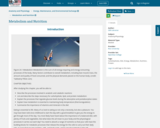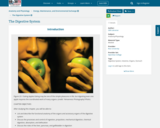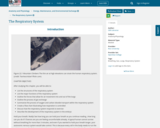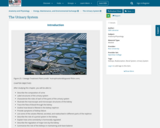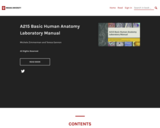
This is a lab manual for Basic Human Anatomy.
- Subject:
- Anatomy/Physiology
- Life Science
- Material Type:
- Activity/Lab
- Provider:
- Indiana University
- Author:
- Michele Zimmerman
- Teresa Gannon
- Date Added:
- 10/19/2020

This is a lab manual for Basic Human Anatomy.
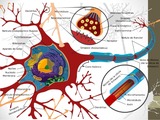
Anatomy and Physiology Lab I slide decks created by Steven Lee M.S. Pathology, FTCC. The PowerPoints include labeled body images to assist students in identifying body parts. Nicole Shaw is only responsible for assisting Steven with licensing his work under an open license and uploading content to the Commons.
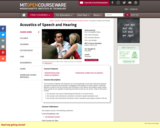
Provides acoustical background necessary to understand the role of sound in speech communication. Analyzes constraints imposed by the properties of sound and human anatomy on speech production (sound production from airflow and filtering by the vocal tract); auditory physiology (transformation of acoustical waves in the air to mechanical vibrations of cochlear structures); and sound perception (spatial hearing, masking, and auditory frequency selectivity). The Acoustics of Speech and Hearing is an H-Level graduate course that reviews the physical processes involved in the production, propagation and reception of human speech. Particular attention is paid to how the acoustics and mechanics of the speech and auditory system define what sounds we are capable of producing and what sounds we can sense. Areas of discussion include: 1. the acoustic cues used in determining the direction of a sound source, 2. the acoustic and mechanical mechanisms involved in speech production and 3. the acoustic and mechanical mechanism used to transduce and analyze sounds in the ear

This text was created by students in PHED 301 - Advanced Anatomy in the Sport, Health & Physical Education department at Vancouver Island University.
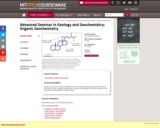
12.491 is a seminar focusing on problems of current interest in geology and geochemistry. For Fall 2005, the topic is organic geochemistry. Lectures and readings cover recent research in the development and properties of organic matter.

This short video covers many anatomical terms.
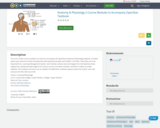
These course modules are meant to accompany the OpenStax Anatomy & Physiology textbook. Included within each subunit are both Articulate Rise 360 exported raw Web and SCORM 1.2 ZIP files. These files are to be Imported into a Learning Management System. Each module contains text and images from the OpenStax book, original text, openly licensed images from various sources, formative activities, and links to videos on public websites. The modules are free to use as needed. If modification is desired, please contact the author, and I will send you the Rise 360 source file.

This lab manual was written for Anatomy & Physiology 2, a 200-level A&P course, at River Valley Community College. The course uses the OpenStax A&P textbook. The manual is intended to complement any text but does derive a good deal of its content from the OpenStax A&P textbook.

An adapted and revised edition of the OpenStax Anatomy & Physiology (https://openstax.org/details/books/anatomy-and-physiology) with revised content and artwork, Open Oregon State, Oregon State University.
The first adapted version may be accessed at: Anatomy & Physiology (https://open.oregonstate.education/aandp1).
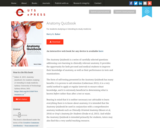
The Anatomy Quizbook is an interactive learning book that will help students and tutors – indeed anyone interested in anatomy – learn, test and improve their knowledge of the human body.
Readers are presented with carefully selected questions and diagrams addressing core learning in clinically-relevant anatomy. This selective rather than exhaustive approach will especially suit time-poor scholars. Regular self-testing will also ensure a robust and strategic understanding of the subject matter.
In this first Volume, you can develop your knowledge of fundamental anatomy, including clinically-relevant terminology and the significant parts and operation of the:
- Thorax, focusing on the heart, lungs, and associated bones, muscles, nerves, blood and lymphatic vessels.
- Abdomen, exploring the stomach, intestines, pancreas, liver, gallbladder, kidneys, spleen and their supporting structures (muscles, nerves, blood and lymphatic vessels).
- Pelvis, examining the bones, ligaments, vessels and nerves of the pelvic region, the features of male and female pelves, and the major digestive and excretory organs (colon, rectum, bladder and urethra).
Whilst developed primarily for students who are studying, or intend to study, medicine, the Anatomy Quizbook will reward all readers who seek to explore and learn about the workings of the human body.
Regular users will find much to learn and build on, hopefully leading to further enthusiasm for a valuable subject that underpins much of medicine.
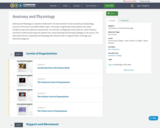
Anatomy and Physiology is a dynamic textbook for the two-semester human anatomy and physiology course for life science and allied health majors. The book is organized by body system and covers standard scope and sequence requirements. Its lucid text, strategically constructed art, career features, and links to external learning tools address the critical teaching and learning challenges in the course. The web-based version of Anatomy and Physiology also features links to surgical videos, histology, and interactive diagrams.

Anatomy and Physiology is a dynamic textbook for the two-semester human anatomy and physiology course for life science and allied health majors. The book is organized by body system and covers standard scope and sequence requirements. Its lucid text, strategically constructed art, career features, and links to external learning tools address the critical teaching and learning challenges in the course. The web-based version of Anatomy and Physiology also features links to surgical videos, histology, and interactive diagrams.
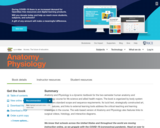
Anatomy and Physiology is a dynamic textbook for the two-semester human anatomy and physiology course for life science and allied health majors. The book is organized by body system and covers standard scope and sequence requirements. Its lucid text, strategically constructed art, career features, and links to external learning tools address the critical teaching and learning challenges in the course. The web-based version of Anatomy and Physiology also features links to surgical videos, histology, and interactive diagrams.

This manual is a guide for anatomy and physiology laboratory exercises. It includes dissection guidance with detailed images; instructions for physiology experiments including foundational content; and gross anatomy study guides for six body systems. Videos and tutorial links provide additional support.


